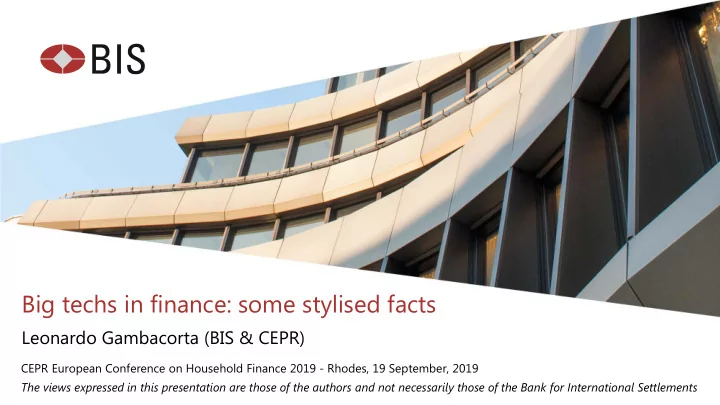

Big techs in finance: some stylised facts Leonardo Gambacorta (BIS & CEPR) CEPR European Conference on Household Finance 2019 - Rhodes, 19 September, 2019 The views expressed in this presentation are those of the authors and not necessarily those of the Bank for International Settlements Restricted
Financial services are a small part of big tech business Big techs’ revenues by sector of activity 1 Regional distribution of big techs’ subsidiaries 4 The sample includes Alibaba, Alphabet, Amazon, Apple, Baidu, Facebook, Grab, Kakao, Mercado Libre, Rakuten, Samsung and Tencent. 1 Shares based on 2018 total revenues, where available, as provided by S&P Capital IQ; where not available, data for 2017. Data accessed on 3 June 2019. 2 Information technology can include some financial-related business. 3 Includes health care, real estate, utilities and industrials. 4 Shares are calculated on the number of subsidiaries as classified by S&P Capital IQ. Data accessed on 3 June 2019. Sources: S&P Capital IQ; BIS calculations. 2 Restricted
Payments were the first financial service big techs offered Big tech mobile payment services Fraction of population with bank accounts, mobile phones and credit cards 1 2017 data. 2 2016 data. 3 Estimate based on the public data for Mercado Libre. 4 Only mobile payments for consumption data (ie excluding mobile payments for money transfer, credit card payments and mobile finance). 5 Advanced economy (AE) average. 6 Respondents who report having an account at a bank or another type of financial institution or report personally using a mobile money service in the past 12 months. Sources: J Frost, L Gambacorta, Y Huang, H S Shin and P Zbinden, “BigTech and the changing structure of financial intermediation”, BIS Working Papers , no 779, April 2019; World Bank; Forrester Research; GlobalData; iResearch; Mercado Libre; Nikkei; Worldpay; national data; BIS calculation. 3 Restricted
Big techs use their network to offer MMFs and insurance products Yu’ebao’s asset composition Maturity of Yu’ebao’s assets Per cent Per cent Days Per cent 1 Share of Yu’ebao’s assets (excluding Treasury bonds) as a fraction of total interbank funding. Total interbank funding is calculated as the sum of outstanding amounts in the interbank CD, repo collateral, outright repo and interbank loan markets. 2 Interbank certificates of deposit. 3 Bonds issued by policy banks including Agricultural Development Bank of China, Export-Import Bank of China and China Development Bank. 4 Financial assets held under resale agreements. Sources: CEIC; WIND; BIS calculations. 4 Restricted
Big tech credit still small but with very different characteristics Big tech credit and banking sector development Elasticity of credit with respect to house prices in China Elasticity Robust standard error in parentheses. ** indicates significance at the 5% level. 1 The ratio is calculated for 2017 and is defined as big tech credit divided by total credit to the private non-financial sector (including total fintech credit). 2 Average over the period 2010–15. 3 Period of estimation: 2005–13. 4 Period of estimation: 2011–17. Sources: J Frost, L Gambacorta, Y Huang, H S Shin and P Zbinden, “BigTech and the changing structure of financial intermediation”, BIS Working Papers , no 779, April 2019; L Gambacorta, Y Huang, H Qiu and J Wang, “How do machine learning and non-traditional data affect credit scoring? Evidence from a Chinese fintech firm”, mimeo, 2019; World Bank; Cambridge Centre for Alternative Finance and research partners; company reports; BIS calculations. 5 Restricted
References BIS (2019). Annual Economic Report. Chapter III: “Big tech in finance: opportunities and risks”, Bank for International Settlements (https://www.bis.org/publ/arpdf/ar2019e3.htm). Frost, Jon, Leonardo Gambacorta, Yi Huang, Hyun Shin, and Pablo Zbinden (2019), “BigTech and the changing structure of financial intermediation”, Economic Policy, forthcoming (also published as BIS Working Paper Series, no. 779). Gambacorta, L., Y. Huang, H. Qiu, J. Wang (2019). “How do machine learning and non- traditional data affect credit scoring? New evidence from a Chinese fintech firm”, BIS Working Paper Series, forthcoming. 6 Restricted
Recommend
More recommend